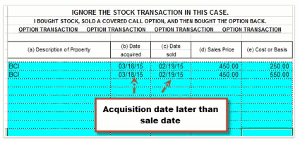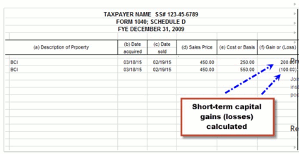Alan Ellman, of TheBlueCollarInvestor.com, discusses why option traders should always strongly consider trading in sheltered accounts whenever possible, highlights the different tax rules for covered call writers, and cites specific capital gain and loss examples for support.
Whether we sell covered calls or cash-secured puts, strong consideration should be given to trading in sheltered accounts whenever possible. Most, if not all, of our trades will be short-term in nature (less than one year), and therefore, will be taxed at the ordinary income tax rate (up to 35%), which is much higher than the short-term capital gains tax rate (15%) if we trade in non-sheltered accounts.
What is a Capital Gain?
This is an increase in the value of as capital asset, such as a stock or an option, which gives it a higher worth than the purchase price. It must be claimed on income taxes in non-sheltered accounts.
Rules for Covered Call Writers:
Premiums received for writing a covered call are not included as income at the time of receipt, but are held in suspense until the writer’s obligation to deliver the underlying stock expires or until the writer either sells the stock, as a result of the call assignment, or by closing the option position (buy-to-close). With that in mind, here are three possible scenarios that may occur after the sale of the option:
- An expired option (we sold the call, we didn’t close the position by buying back the option and the holder did not exercise the option) results in a short-term capital gain. For example, we sell a BCI April 90 call for $4.50 in March. The proceeds are $450. Since the cost is $0, the short-term capital gain is $450. The acquisition date will be later than the sales date and the word “Expired” should be written in column e, the cost basis column.
- If we buy back the same option in the above example to close the position (usually to execute an exit strategy), the difference between the sale profit and the buyback cost will represent a capital gain or a capital loss. As in example 1, above, the acquisition date will be later than the sales date.
Capital gain example: We close our position by buying back the option for $250. The capital gain is $200 ($450 – $250).
Capital loss example: We close our position by buying back the option for $550. The capital loss is $100 ($550 – $450).
- If the option is exercised, the option transaction becomes part of the stock transaction. The option premium is added to the strike price received, less commissions. If the stock has been held for less than one year, the entire transaction will be treated as short-term. If the stock had been held for one year or more, the entire transaction will be treated as long-term as the option holding period is ignored.
*The Schedule D of the Elite Calculator is designed to assist your tax advisor with these long- and short-term capital gains (losses) issues:

Acquisition date later than sale date
Click to Enlarge

Capital gain (Loss) calculations
Click to Enlarge
The specific information referenced above can be found in IRS Publication 550 entitled Investment Income and Expenses, pages 57–58.
I avoid these tax issues by trading covered call stock options predominantly in tax-sheltered accounts.
In an upcoming article, I will discuss capital gains and losses related to selling cash-secured puts.
*Contact your tax advisor before making any investment tax-related investment decisions.
By Alan Ellman of TheBlueCollarInvestor.com





















